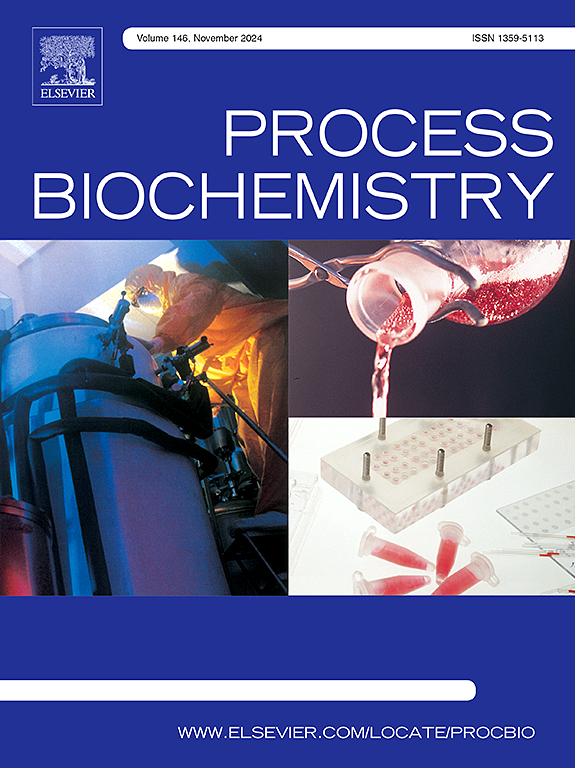One-pot chemo-enzymatic cascades using ene-reductase and alcohol dehydrogenase to produce a brivaracetam chiral precursor
IF 3.7
3区 生物学
Q2 BIOCHEMISTRY & MOLECULAR BIOLOGY
引用次数: 0
Abstract
Brivaracetam is a third-generation antiepileptic drug containing two chiral centers (2S, 4 R). To achieve effective asymmetric synthesis of 4 R chiral center, a novel one-pot chemo-enzymatic cascade strategy was developed to synthesize the 4 R chiral precursor, (R)-4-propyldihydrofuran-2(3H)-one (1b). The butenolide 5-hydroxy-4-propylfuran-2(5H)-one was selected as the starting substrate due to the presence of an active electron-withdrawing group, which enabled rapid enzymatic reduction by an ene-reductase with > 99 % conversion. However, this reaction generated a racemization-prone intermediate. Subsequent reduction using a newly identified alcohol dehydrogenase (YahK) demonstrated high activity but exhibited S-configuration stereoselectivity. Through semi-rational engineering, the stereoselectivity of a YahK triple mutant (G132T/T182A/M313R) was successfully reversed to favor the R-configuration. The chemo-enzymatic cascade combining ADH reduction and chemical cyclization yielded the chiral product 4R-1b with an enantiomeric excess (ee) of > 91 % (R). Notably, the one-pot mode further enhanced the ee value of the final product to > 98 %. This strategy effectively bypassed the limitations of low-reactivity alkene substrates, enabling efficient construction of the 4 R chiral center in brivaracetam.
使用烯还原酶和醇脱氢酶进行一锅化学酶级联反应,生产布伐西坦手性前体
布瓦西坦是含有两个手性中心(2S, 4 R)的第三代抗癫痫药物。为了实现4 R手性中心的有效不对称合成,提出了一种新的一锅化学-酶级联策略来合成4 R手性前体(R)-4-丙基二氢呋喃-2(3H)- 1 (1b)。丁烯内酯5-羟基-4-丙基呋喃-2(5H)- 1被选为起始底物,因为它有一个活跃的吸电子基团,可以通过酶还原酶快速还原,转化率为 99 %。然而,该反应产生了易于外消旋的中间体。随后使用新鉴定的醇脱氢酶(YahK)进行还原,表现出高活性,但表现出s构型立体选择性。通过半理性工程,成功地逆转了YahK三突变体(G132T/T182A/M313R)的立体选择性,使其倾向于r构型。结合ADH还原和化学环化的化学酶级联反应得到手性产物4R-1b,其对映体过量(ee)为>; 91 % (R)。值得注意的是,一锅模式进一步提高了最终产物的ee值至>; 98 %。该策略有效地绕过了低反应性烯烃底物的限制,使布瓦西坦中4 R手性中心的高效构建成为可能。
本文章由计算机程序翻译,如有差异,请以英文原文为准。
求助全文
约1分钟内获得全文
求助全文
来源期刊

Process Biochemistry
生物-工程:化工
CiteScore
8.30
自引率
4.50%
发文量
374
审稿时长
53 days
期刊介绍:
Process Biochemistry is an application-orientated research journal devoted to reporting advances with originality and novelty, in the science and technology of the processes involving bioactive molecules and living organisms. These processes concern the production of useful metabolites or materials, or the removal of toxic compounds using tools and methods of current biology and engineering. Its main areas of interest include novel bioprocesses and enabling technologies (such as nanobiotechnology, tissue engineering, directed evolution, metabolic engineering, systems biology, and synthetic biology) applicable in food (nutraceutical), healthcare (medical, pharmaceutical, cosmetic), energy (biofuels), environmental, and biorefinery industries and their underlying biological and engineering principles.
 求助内容:
求助内容: 应助结果提醒方式:
应助结果提醒方式:


